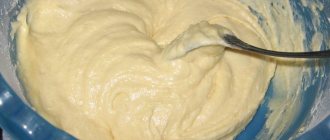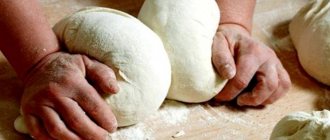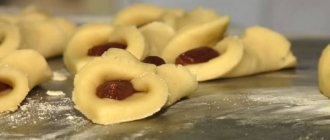I searched for the topic and couldn't find it. Please tell me what to do if the dough turns black. Today I made dumplings with strawberries and after cooking the dough turned black, which is why this happened
Dough composition: sour cream, flour, water, salt, oil,
The dough often darkens from the juice from the berries. Dumplings with cherries also darken, even with the most correct dough. Not always, but very often. I don't know what's going on here. It seems to me that if you roll it out a little thicker, it won’t darken. more precisely, it doesn’t get dark to such an extent.
I also do not exclude options for guests 1 and 2 - impurities, dyes, flavors, aluminum cookware.
Use and reprinting of printed materials from the woman.ru website is possible only with an active link to the resource.
The use of photographic materials is permitted only with the written consent of the site administration.
Posting intellectual property objects (photos, videos, literary works, trademarks, etc.) on the woman.ru website is permitted only to persons who have all the necessary rights for such posting.
Copyright (c) 2016-2018 Hirst Shkulev Publishing LLC
Online publication “WOMAN.RU” (Zhenshchina.RU)
Certificate of registration of mass media EL No. FS77-65950, issued by the Federal Service for Supervision of Communications, Information Technologies and Mass Communications (Roskomnadzor) on June 10, 2016.16+
Founder: Limited Liability Company "Hirst Shkulev Publishing"
Editor-in-Chief: Voronova Yu. V.
Editorial contact information for government agencies (including Roskomnadzor):
Housewives often have to solve the problem - what to do with excess dough? We made pies, ran out of filling, but left the dough, or simply kneaded it too generously, or bought it in excess at the deli. How long and how to store the dough so that it does not lose its properties, and what conditions are needed for this?
Yeast
It was not for nothing that he was considered alive in Rus'. It “breathes” as it rises in the pan, and even “talks” if the air bubble suddenly bursts. The reason for this is yeast, which ensures the fermentation process. Therefore, you cannot leave the dough indoors, especially overnight: it will definitely turn sour.
If this happens, the only thing that can be done is to dilute the sour mixture with milk and immediately fry the pancakes. But it can no longer be used for making pies.
Is it possible to store yeast dough? Yes, but for this you need to know a number of nuances. And remember that the mentioned periods are only suitable for the semi-finished product that you know when it is cooked.
The only place where yeast dough can be stored is in the refrigerator. True, in winter an unheated balcony is suitable for this purpose.
How to store yeast dough in the refrigerator?
If there is little product left after cooking, put it in one plastic bag. If the quantity is large, divide it into several pieces. To prevent them from sticking to your hands and the walls of the bag:
- lightly dredge lumps in flour;
- or, moisten your hands in vegetable oil, give them the shape of koloboks.
The plastic bag for storing yeast dough should be strong enough (some housewives use two) and spacious. Indeed, at a temperature that is usually kept in the refrigerator (4-6 ° C), the yeast only slows down, but does not stop its vital activity. Therefore, at least slightly, the mass will rise here too. You need to leave room for this, otherwise the package will be torn.
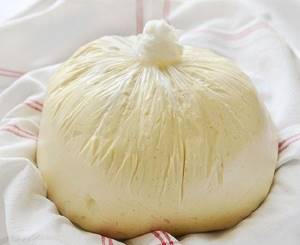
How long can yeast dough be stored in the refrigerator? The correct answer is one day, maximum two. The longer it stays there, the greater the risk that it will become sour.
About mixing the dough and destroying the gluten
Friends, today we’re talking about mixing wheat dough. Everyone is afraid of mixing dough, especially those who have never really mixed dough and don’t know what it looks like. Most still under-mix, mistaking stickiness and looseness for over-mixing. Here is some important information about mixing dough and destroying gluten, which will allow you to better manage bread dough and not give in to panic in difficult moments.

First: you can’t mix it with your hands. This is true!))
Human hands are not able to work so quickly and heat the dough so much as to destroy the wheat protein, but it’s easy to under-knead! During the kneading process, it is sometimes difficult to understand whether the dough is too low or too high: it tears, sticks, does not form into a ball, becomes very loose, and recently it seemed to be smooth. The first thing to remember: the dough in the kneading develops unstably, it does not get better and better, but changes its properties, which we can evaluate as everything good or bad, but the dough at the same time (almost always) develops! You mix flour and water, the flour begins to moisten, the proteins and starches swell, the gluten begins to form its first bonds, so the baking properties of the dough improve dramatically. Further, as kneading proceeds, it both improves, becoming smoother, and worsens, becoming more loose, often after a state that seems almost ideal to us. This unstable but completely natural behavior of the dough sometimes throws bakers into panic.
On this graph from the book by L.Ya. Auerman “Baking Technology” (p. 122) the behavior of the dough in the kneading is reflected very clearly:
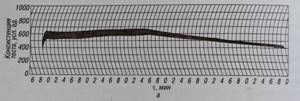
And here is the comment:
How do you know when the dough is ready and you have enough kneading?
I can describe it to you in words, but practice will tell you more and better. For me, the main guidelines are as follows: the dough becomes smooth and elastic when worked with, under strong tension, tension, shows a smooth side (the gluten window has the same meaning - to maintain smoothness and integrity under stretching and tension) and stops tearing, the looseness goes away. And I also know that readers can understand these words in absolutely their own way, so I insist on your experience and your practice))

How can you understand what is actually happening to the dough if it seems like it has been over-kneaded?
Temperature!
Measure with a probe; if the temperature is under 30°, then misalignment is very likely. If you don’t have a probe, then just touch it with your hand; if it’s warm, this is a reason to be wary: when the temperature inside the dough reaches 25°, enzymes begin to work more actively, fermenting and destroying the dough faster, and the warmer it is, the faster the destructive processes.
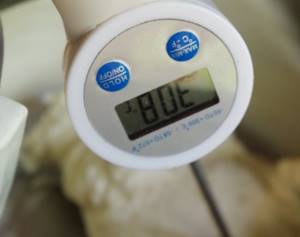
This does not mean that warm dough is always destroyed, it also depends on the quality of flour, but this is true at all stages of working with dough and for all types of wheat dough, especially wet dough, so this factor should always be kept in mind. To avoid overheating of the dough, experienced bakers advise using ice water if necessary, monitoring the temperature of the dough during the batch and during fermentation, and refrigerating the dough if necessary. By the way, wet dough, when warm, does not knead at all, so the best thing you can do for it is to stop the mixer and cool the dough.
Kneading time.
For example, in the Ankarsrum , kneading wheat dough on average lasts about 25-35 minutes. at 2-2.5 speed, therefore, if the dough in the dough mixer tears and sticks, and it’s only the 15th minute of kneading, the flour is the usual, the dough is not warm, then it’s definitely not kneaded and it’s too early to stop! For planetary mixers and professional dough kneaders, a different kneading time is relevant; they work faster and more aggressively.
The kneading time depends not only on the type of machine you knead with, (for example, those that imitate manual kneading, like Ankarsrum , always work slower and more gently). The quality of the flour also influences: the “stronger” the flour, the higher the percentage of gluten in it and the stronger it is, the more time it takes to knead.
Experiment!
Especially for this article, I conducted an experiment and specifically did everything in such a way as to destroy the gluten of the dough: I took warm water, kneaded at Ankarsrum (usually 2-2.5), the process and the result amazed me! At the fortieth minute of kneading, the dough became so beautiful and smooth that I couldn’t believe my eyes! However, given the time (long), speed (fast!) and temperature of the dough (warm, above 30°), this just indicated that it was collapsing!
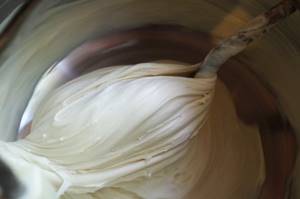
Wheat gluten has the ability to stretch, maintaining its integrity and returning to its original shape. The ability to stretch is given by the protein gliadin, and the ability to be elastic is given by glutenin. As a result of over-kneading, glutenin is destroyed and the dough becomes both very, very extensible and has less and less ability to resist (and when it resists, it breaks). The further you knead the dough, the softer and smoother it becomes precisely because of the gradual loss of the ability to resist stress, and this does not happen abruptly, but gradually.
Fold the dough!
If you are kneading in a mixer or dough kneader and are in doubt about whether it is over- or under-kneaded, try folding the dough, bringing it into a tense state and listening to your feelings. And in case of over-kneading, the dough can tear, and in case of under-kneading, only this will happen for different reasons and will be felt differently. Under-mixing means weak gluten bonds, the dough is weak because it has not yet become strong, therefore, resisting and coming into tension, it still breaks the gluten bonds and breaks itself. Overmixing is when the bonds are destroyed or in the process and the dough tears and creeps, offering virtually no resistance to your actions. You pull it - it does not strive to maintain its shape, almost does not come into tension, and its surface is easily and quickly covered with ripples of small cracks and is generally very easily injured.
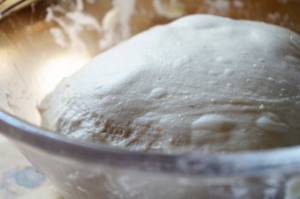
Give the dough a rest and fold it!
If after this you still have doubts and you still don’t understand what’s wrong with the dough, leave it in a container or bowl, covered with something to prevent airing, for about 30 minutes. If the dough is warm, put it in the refrigerator. After half an hour, fold it and very carefully observe the behavior of the dough: the unmixed dough will significantly improve its properties, become smoother and more elastic, the mixed dough will still break into small cracks and crawl.
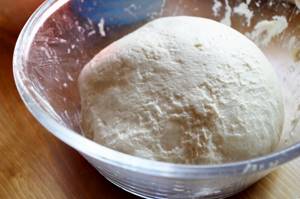
For comparison, “normal” dough after folding like this:

Gluten - muscles of wheat dough
There is an interesting observation here: the dough develops gluten, as if it were growing a muscle, which, like a human muscle, develops effectively when the load in relation to it alternates with rest and relaxation. They gave it a load, strained it in the knead (both their muscles and the muscles of the dough), then stretched it (stretch!), rolled it into a ball, and left it to relax and ferment. We waited for the dough to relax properly, folded it, stretched it and rolled it, i.e. brought him into a tense state again. This is the magic of folding! They significantly improve the quality of the dough, allowing the gluten bonds to become even stronger and form threads and films even better, i.e. what we call the gluten framework. But such a miracle only happens with dough where gluten has a potential that it needs to realize; if the wheat protein is destroyed or in the process of destruction, then folding will not help, the potential is exhausted.
How to avoid over-mixing the dough? A few very simple rules:
Monitor the temperature of the dough, use cold/ice water if necessary. It is advisable that the dough temperature does not exceed 25°. It is advisable, if suddenly it is higher, it is not a fact that everything is gone, cool the dough in the refrigerator for 30-60 minutes, folding it a couple of times so that the temperature is distributed more evenly and it cools more evenly and faster.
Do not overload the dough mixer! If there is more dough in the bowl than needed, the mixer will inevitably overheat it because it will take longer to process the larger amount of dough. How do you know how much you need for your mixer/dough mixer? Divide the volume of the bowl in liters by two - this will be the optimal weight of dough for your machine. For example, the volume of the Ankarsrum is 7.5 liters, which means that I can knead almost 4 kg in it without any problems. wheat dough! Of course, keeping an eye on the temperature))
Keep track of the time. Mixers and professional spiral kneaders knead faster, but also heat the dough more intensely. Ankashroom imitates manual kneading, stretches and folds or beats, so the kneading lasts half an hour or a little more at 1.5-2.5 speeds (depending on the consistency of the dough), owners of a mixer should not rely on this time.
DO NOT knead wet dough in mixers: it scatters the wet dough along the bottom, heats it up, but the gluten of the dough does not develop, because the mixer is physically unable to bring the wet dough into tension. You can knead a thick or soft dough by adding some of the water (in your case, ice!) according to the recipe, and then add additional moisture by hand or with a mixer, then you get something like double hydration. It seems to me that bakers came up with this technique specifically for kneading wet dough in mixers)) And remember, it’s always better to under-knead than to over-knead!
Experiment!
Finally, I want to show you episodes of my experiment with mixing dough. The batch lasted about 60 minutes. with a short break, the speed was about 4, the dough in the process was indescribably beautiful and smooth, I didn’t want to torture it, but what can’t you do for the sake of an idea when you’re a fanatic)) Here’s a video to prove it. I filmed and cried))))
After molding the bread, proofing took about 14-15 hours at 5-6°, this saved it)).
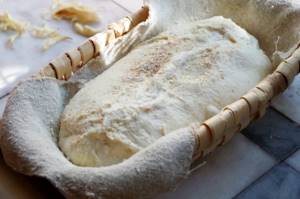
Before baking and cutting:
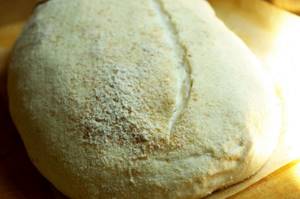
And this is what happened in the end! Guys, well, this is fantastic, how beautifully it unfolded!
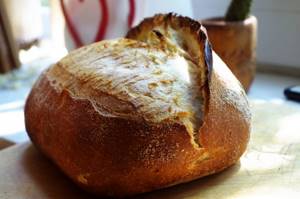
But pay attention to the roughness of the opening, when the bread opens like this, this indicates the weakness of the gluten (for various reasons).
And here's the cut:

The crumb is cotton! And the taste is poor, but rich, similar to ordinary yeast bread. I know many people will like it, but it’s too simple for us))
But a normal French bun))
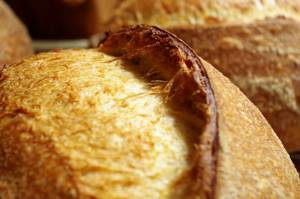
I hope you found it interesting, useful and didn't fall asleep (sorry for the long article). For me it’s still like a good, incredibly exciting detective story))
Good luck and see you soon!
wheat bread, article, working with dough
For pancakes and pancakes
The main component of this mass is milk or fermented milk products, as well as eggs. Therefore, it has the shortest shelf life.
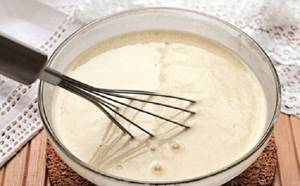
How to save? It is advisable to leave the dough in the refrigerator for no longer than a few hours, a maximum of a day.
The lid on the pan should be tightly closed to limit the flow of air. But even in this case, you need to open the pan and stir the mass so that its consistency is not disturbed.
You cannot store pancake dough in the freezer: during defrosting, liquid will release and you will no longer get a homogeneous composition.
For dumplings and dumplings
Although dumpling dough does not contain yeast, it also requires delicate handling. It cannot be stored at room temperature - it will dry out by evening. Moreover, leave it warm overnight. In the refrigerator, the mass will not lose its properties for 3 days, but products made from it will be different - less soft and tender.
We answer the question: why does the dough darken in the refrigerator?
The dark color appears mainly due to oxidative processes in the flour. Therefore, it is important to limit air access to the product.
If there are no eggs in the dough, then darkening is not a sign of spoilage. But if the batch was made with eggs, then such a mass cannot be used.
The optimal storage place is a food container with a lid. Lightly sprinkle the sides of the container with flour. You can use food grade film instead.
The shelf life of the dough is quite long - it can be kept in the freezer for a month.
Dough for dumplings is stored in the same way. If you do keep the semi-finished product in a warm place and it begins to sour slightly, you can fry it into delicious flatbreads or make dumplings for soup.
LiveInternetLiveInternet
Quote from message Galina5819
Read in full In your quotation book or community!
Yeast dough in vegetable oil - kneaded the dough in the evening, and in the morning... homemade baking
A new recipe for yeast dough, which we will prepare in vegetable oil. This is a lean option, so it will certainly come in handy for many housewives. Based on this dough, you can easily make pies with any filling, either in the oven or fry them in oil on the stove.
By the way, another distinctive feature of this yeast dough is that it will ferment not in a warm place, but in the cold. True, for quite a long time - all night. But this makes it even more convenient - you knead the dough in the evening, and in the morning you can prepare homemade cakes.
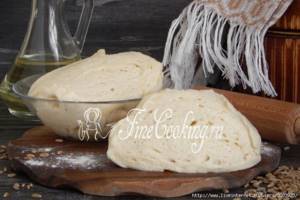
Of course, I can’t help but share my impressions (I made this yeast dough for the first time). I liked everything about it: the set of ingredients is minimal, the kneading is simple and quite fast, the dough fits well in the cold, the pies are molded perfectly, and they turn out tasty and fluffy...
But it does have one drawback: ready-made baked goods made from overnight dough in vegetable oil quickly become stale. Literally on the second day, the dough in the pies began to harden. Not like a cracker, of course, but if you compare yeast dough with milk with eggs, the difference is significant. True, there is a way out: you can heat the pies in the microwave (20 seconds) or in the oven (about 3-4 minutes). Then you will need to eat them right away!
Premium wheat flour (400 grams) Water (170 milliliters) Vegetable oil (90 milliliters) Sugar (1 tablespoon) Instant yeast (1 teaspoon) Table salt (0.5 teaspoon)
To prepare this lean yeast dough, we will need the following ingredients: wheat flour (I use premium grade, but first grade will do), drinking water, refined vegetable oil (I use sunflower), salt, granulated sugar and instant yeast. You don’t have to take fast-acting yeast - just dry yeast (1 level teaspoon is 3 grams) or pressed/fresh will work perfectly (we take 3 times more, that is, 9-10 grams). Such yeast is not immediately mixed with flour, but is pre-activated in a warm, sweetish liquid for 10-15 minutes. In our case, you can slightly heat half a glass of water with a tablespoon of sugar and dissolve the yeast in it.
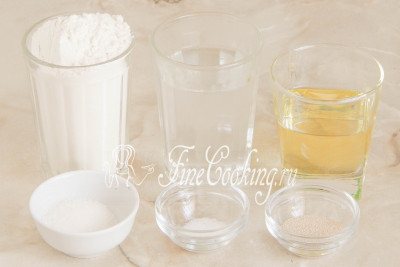
Sift the wheat flour into a bowl (preferably twice). Due to this, the flour will not only loosen and be saturated with oxygen, but also possible debris will be removed. We will leave about a quarter of a glass, since its humidity is different for everyone, so the dough also takes a different amount of flour (sometimes the difference can be very significant).
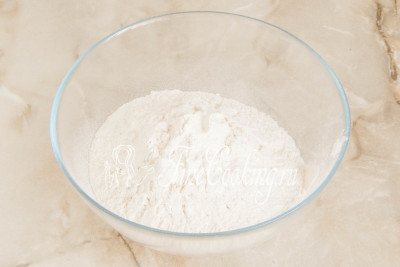
Add instant yeast, granulated sugar and salt to the flour. Mix everything thoroughly with a fork or whisk.
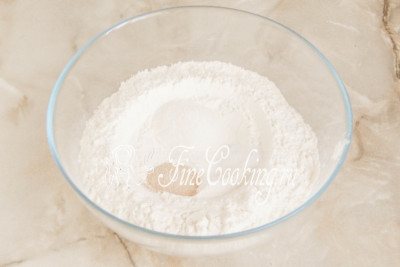
Make a well in the flour and pour lukewarm drinking water and odorless vegetable oil at room temperature into it.
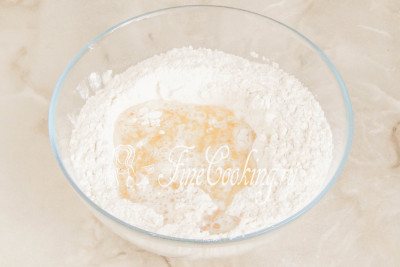
You need to knead this yeast dough for quite a long time (about 10 minutes) - during this time it will become smooth, homogeneous, quite soft and tender, decently greasy to the touch, and at the same time quite a bit sticky. We round the dough into a ball and place it in a bowl, which we grease with a drop of vegetable oil so that it does not stick to the dishes during the fermentation process.
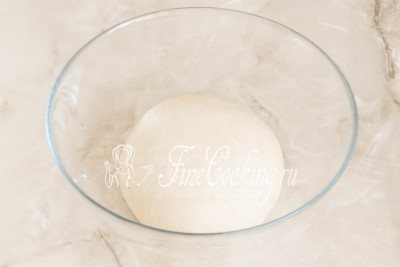
Cover the bowl with the dough with cling film or cover with a lid. Place in the refrigerator for 6-10 hours. It is most convenient to knead this dough in the evening and use it for baking in the morning.
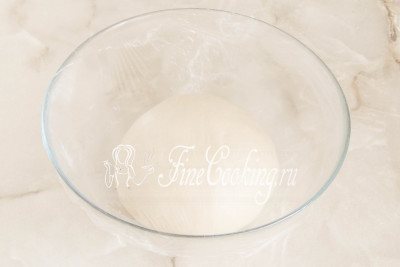
In the morning, the yeast dough in vegetable oil has increased in volume by 4 times. The weight of the dough is 680 grams - this is enough for 10-15 pies.
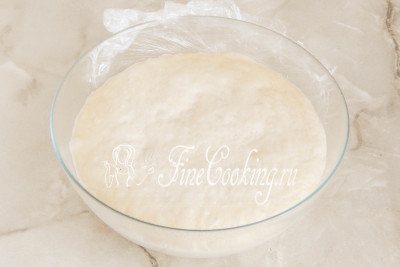
It is very loose, permeated through with air bubbles. However, it is quite dense and cold, so before working it is advisable to knead the dough and let it warm at room temperature for 30-40 minutes. After it, you can start shaping future baked goods.
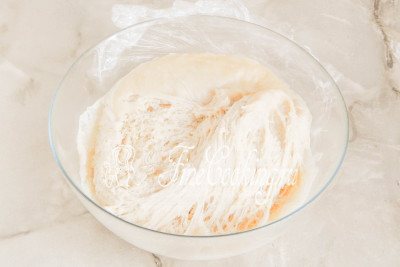
I made pies with apple jam . Our family loved them and most of them disappeared from the table while still hot. I kept a couple for 3 days - as I wrote above, the dough in the pies quickly becomes stale.
 from this dough](https://superlady555.ru/wp-content/uploads/shag-9-ya-ispekla-iz-etogo-testa-pirozhki-s-yablochnym.jpg)
I hope this yeast dough recipe will be useful to many housewives. Have fun cooking, friends!
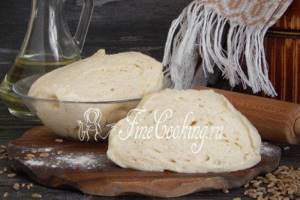
Yeast dough with vegetable oil
Puff
How long does puff pastry last? Here a lot depends on whether it contains yeast or not.
- It is recommended to store yeast puff pastry at room temperature for no more than an hour, in the refrigerator for up to 2 days, and for 12 months in the freezer, provided that it does not defrost.
- For yeast-free, these periods increase slightly. Accordingly, 2 hours in the room, 3 days in the refrigerator, and the same 12 months in the freezer.
The optimal container is cling film and a container sprinkled with flour.
If you bought ready-made frozen dough in a store, and it managed to defrost on the way home, keep it in the refrigerator and use it within the next 24 hours. It cannot be re-frozen.
Storing homemade dough
It is worth separately considering storing the dough on the refrigerator shelf and in the freezer:
- On the shelf of the refrigerator - in this case, you can store it for no more than one night. If the time is longer, the dough will sour. Therefore, you need to prepare a small mass, roll it into a ball, grease it on all sides with vegetable oil, place it in a dry bag and tie it tightly. You need to make a hole in the bag for air to escape and place it on the top shelf of the refrigerator. The temperature in this case should be no more than 8 degrees Celsius.
- In the freezer, the shelf life at a temperature of -15 reaches 2-3 months. In this case, neither the taste nor nutritional characteristics will be spoiled. It is better to store the dough in food containers in different portions so that there is no re-freezing if you do not take the entire mass. The walls of the containers should be coated with oil, and the dough itself should be covered with cling film. It is also very important that the lid is tightly closed. You can only take out containers if you are cooking now.
Thus, if the dough is stored correctly, it can be left in the refrigerator. However, do not neglect the advice given above for the sake of your safety and your health! Bon appetit!
Sand
Shortbread dough - sweet, soaked in butter, crumbly - lies quite well. When storing it, you can follow the general rules:
- Divide the entire available mass into pieces sufficient, for example, to bake cookies once.
- Divide portions into containers or bags and store in the refrigerator for up to 5 days.
- Shortbread can remain in the freezer for 3 months without losing its taste properties.
Many housewives believe that the dough should be specially frozen - after this it only becomes tastier.

Custard
This dough is special - it is neither dense nor liquid, so it is especially important to create suitable conditions for its storage.
The mass will be good for the longest time if you first place it in a bag or cling film, and then put it in a container. 3-4 days is the “life” of the dough in the refrigerator. You can also freeze the custard. In the freezer, the product may remain usable until defrosted.
Prepared eclairs made from choux pastry are stored for the same amount of time.
The dough is called choux because when preparing it, part of the flour is poured with boiling water and brewed for up to several hours. This creates large voids in the finished product, which are filled with cream or other filling.
Knowing the storage features of each type of dough, you will always be “fully armed.” Baking from a product that has been saved according to the rules is delicious, and a piece of dough removed from the freezer will allow you to pamper your household with delicious pies even in the days before payday.
And how to store it: on a shelf or maybe freeze it?
Author of the publication
repairer
Achievement received 08/22/2018
